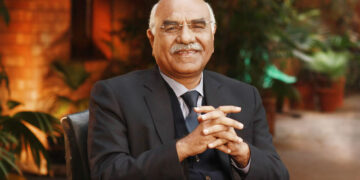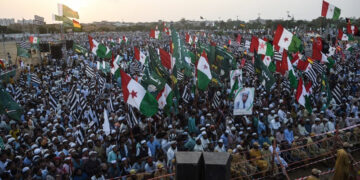 The night of May 1, 2011 is likely to have changed that forever for it was the last abode of the world’s most wanted terrorist, Osama bin Laden. Ironically, the man on whose head rested a $25 million bounty was living in a high walled house only a few hundred yards from the prestigious military academy of Kakul. So much for the caveman theory. Moving beyond the hows and whens, the event is likely to prove cataclysmic for all stakeholders. For President Obama, it is sure to clinch electoral victory and another term in office. It has also provided the much sought after closure to the families of the victims of 9/11 and other terror attacks perpetrated by Al Qaeda.
The night of May 1, 2011 is likely to have changed that forever for it was the last abode of the world’s most wanted terrorist, Osama bin Laden. Ironically, the man on whose head rested a $25 million bounty was living in a high walled house only a few hundred yards from the prestigious military academy of Kakul. So much for the caveman theory. Moving beyond the hows and whens, the event is likely to prove cataclysmic for all stakeholders. For President Obama, it is sure to clinch electoral victory and another term in office. It has also provided the much sought after closure to the families of the victims of 9/11 and other terror attacks perpetrated by Al Qaeda.
While the extent of Osama’s involvement in these is questionable, the truth is that he epitomised the ‘brand’ Al Qaeda. At this point it is important to recall Obama’s words on continuing the war in Afghanistan. The principal objective for the US-led war was to “dismantle, destroy and defeat Al Qaeda.” While bin Laden’s iconic figure since he was literally the face of terrorism post September 11, has now been successfully eliminated, the war on terror is far from over. On the other hand in Pakistan, politicians of every stripe are demanding the ouster of the United States and NATO from the region. Even the US, while congratulating itself on this major achievement has made it clear that the war on terror is far from over.The bigger question is to how, when or more importantly, ‘will’ this war ever be over? Al Qaeda may have been founded by bin Laden —who along with his Egyptian counterpart Dr Ayman Al Zawahiri masterminded major attacks and provided the core leadership — but it has evolved into an extensive and diffused network. More importantly, it is not a hierarchical organisation. The absence of that traditional centralised structure has rendered it strong enough to withstand the removal or exit of any person in the singular and the plural. It is more or less a radicalised brand name, too widespread and self sufficient to collapse because what is seen as the foundation stone is removed. The hundreds of radicalised youth in Europe and even the US may never have had access to the Al Qaeda chief in their life times but their extremist inclinations and propensity to challenge security under the Al Qaeda banner remained steadfast.
More importantly, the operation carried out by US Special Forces flown in on helicopters, (speculation is that these were flown in either from eastern Afghanistan or from the base loaned to the Americans by the Pakistan military at Tarbela Ghazi) highlights the bigger issue of the trust deficit and Pakistan’s role in the whole operation.Washington has denied sharing any intelligence of the operation with any country including Pakistan and has claimed the operation as a sole US initiative. In keeping with the US line, President Asif Ali Zardari has also laid to rest speculation that it was a joint operation. However, President Obama’s comments post operation indicates that intelligence cooperation with Pakistan led to the successful culmination of the hunt for bin Laden.Despite the denials, there is good reason to believe that Pakistan’s intelligence and military were cognisant of the operation. Credible intelligence sources have affirmed that knowledge of the operation was shared at the highest level. This is even as an ISI official reportedly told BBC that they were highly embarrased by the operation, not having kept the house bin Laden was staying in on their radar despite the same house having been used by another al Qaeda operative, Abu Faraj al-Libby in 2003.However, it is highly unlikely that Pakistan was not aware and was not informed of the operation. Irrespective of talk of radar jamming, the helicopters were easily observable and it is not possible that nobody observed, intercepted or questioned these. That leads us to conclude Pakistan’s knowledge of and approval of the operation. But why it was conducted solely by the United States may be because of two reasons.
A) The US insisted, wanting to ensure a foolproof operation given the high value target. A statement from the Pakistan Foreign Office while defending allegations of violation of sovereignty said that the US has always maintained its intent to conduct independent operations in the case of evidence of Al Qaeda’s top leadership presence in any country.
B) Pakistan may have wanted to wash its hands off the affair fearing reprisals and a severe backlash.
Ever since joining the anti-terror coalition, Pakistan has been the biggest victim of terrorism. It has incurred the loss of almost 30,000 civilians and thousands of security personnel, not to forget the massive economic losses.Incidentally it has also been the only anti-terror ally that has helped the US capture and kill the largest number of Al Qaeda terrorists. So allegations of complicity in providing a safe haven to Al Qaeda leadership are simply baseless. It seems that the “epicenter of terrorism” is being defined simplistically in terms of Al Qaeda presence alone. Why would that surprise anyone given the exodus of almost 200 Al Qaeda operatives and its core leadership across the border after the Tora Bora attack?Questions pertaining why Osama wasn’t discovered so far are a bit naïve. Even the US with all its sophisticated intelligence could not determine the whereabouts of Osama in nine years until now. Osama was hardly going to live in a place, which would come under suspicion, so naturally a city and a high security locale would be the preferable option. In addition, the presence of bin Laden in the ‘Waziristan mansion’ in Abottabad may have been unnoticed because the absence of security guards and lack of movement around the place were taken for granted and life went on around him. Much the same way that the US maintains individuals in safe houses. They just blend. Apparently, Osama’s whereabouts were traced by tracking the Kuwaiti courier and that too not in Pakistan but outside by the American intelligence.
It is hoped that one gets a clearer perspective in the coming days. But Pakistan’s contribution cannot be undermined. Lest people forget, it was Pakistan’s intelligence and security forces that have helped in netting some of the biggest names in Al Qaeda — including Abu Zubaydah, Ramzy bin al-Shibh, Khalid Shaikh Mohammed and Abu Faraj al-Libby — in operations conducted by Pakistani forces.A word of caution for the United States: netting Osama is the best thing that could have happened for Obama but he was effectively dead since almost a decade. While this may be a big morale booster, it is time to review the war in Afghanistan and fast track the effort to bring about a political settlement to the insurgency. – Khaleejnews












